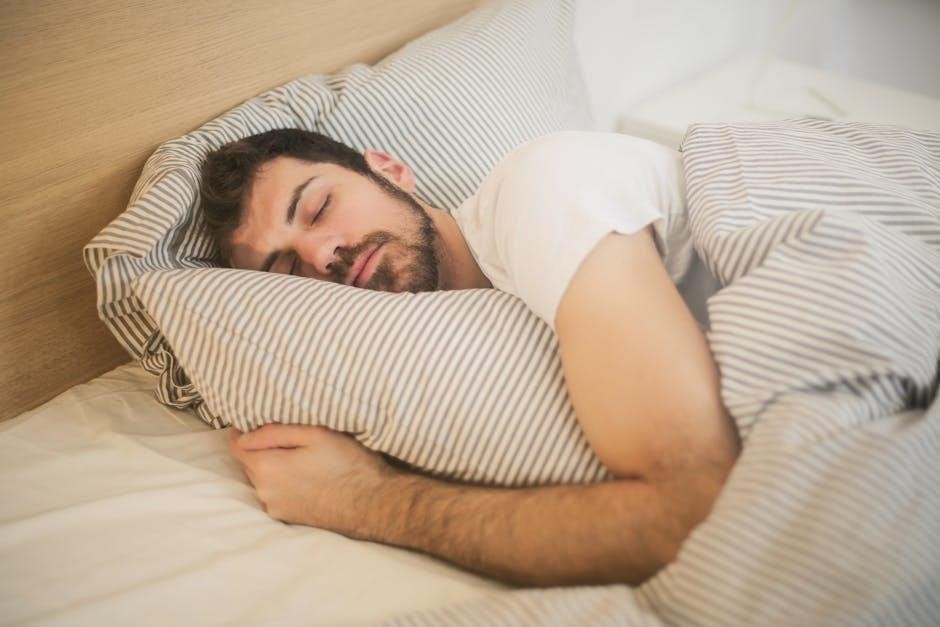Sleep-deprived EEG instructions guide patients through specific protocols to enhance brain activity detection, particularly for epilepsy diagnosis, ensuring accurate test results through controlled sleep restriction and preparation.

1.1 Overview of Sleep-Deprived EEG
Sleep-deprived EEG is a diagnostic procedure where patients undergo partial or total sleep deprivation to enhance the detection of brain activity abnormalities. It involves specific protocols, such as waking at 02:00 and avoiding stimulants, to increase the likelihood of capturing epileptic discharges or other anomalies. The process typically includes a 2.5-hour EEG recording session, often between 08:00 and 10:30, without additional activation procedures. Sleep deprivation is particularly useful for diagnosing epilepsy, as it heightens cortical excitability, making it easier to detect interictal abnormalities. However, it carries a small risk of provoking seizures, especially in conditions like juvenile myoclonic epilepsy (JME). This method is widely recognized for improving diagnostic accuracy in challenging cases.
1.2 Importance of Sleep Deprivation in EEG Testing
Sleep deprivation in EEG testing is crucial for enhancing the detection of epileptic activity and other brain abnormalities. By restricting sleep, cortical excitability increases, making it easier to identify interictal spikes and patterns. This method is particularly effective in patients with suspected epilepsy, as it elevates the yield of EEG recordings. Studies have shown that sleep-deprived EEG can reveal abnormalities not visible in routine tests, improving diagnostic accuracy. Additionally, it serves as a cost-effective alternative to pharmacological sleep induction, reducing reliance on sedatives. Overall, sleep deprivation is a valuable activation procedure that aids in obtaining more informative EEG results, especially in complex neurological cases.
Preparation Guidelines for Sleep-Deprived EEG
Preparation involves sleep restriction, avoiding stimulants, and lifestyle adjustments to ensure optimal brain activity recording during the EEG procedure for accurate diagnostic results.
2.1 Sleep Restriction Protocols
Sleep restriction protocols involve limiting sleep hours before the EEG to enhance brain activity detection. Adults may be asked to wake at 02:00 and remain awake, with EEG recording from 08:00 to 10:30. Children under 16 should sleep no more than five hours the night before. These protocols aim to increase the likelihood of capturing abnormal brain activity, especially in epilepsy cases. Patients are advised to avoid napping and follow specific sleep schedules provided by neurologists to ensure the procedure’s effectiveness and accuracy in diagnosing neurological conditions.

2.2 Lifestyle Adjustments Before the Procedure
Lifestyle adjustments are crucial to prepare for a sleep-deprived EEG. Patients should avoid stimulants like caffeine and alcohol 24 hours before the test. A light meal is recommended to prevent discomfort during the procedure. Strenuous physical activity and excessive screen time should be minimized to promote natural sleepiness. Mental relaxation techniques, such as reading or listening to calming music, can help reduce stress. Patients are also advised to avoid napping after midnight and ensure they are well-rested before the sleep deprivation period begins. Adhering to these adjustments ensures the EEG captures accurate brain activity, enhancing diagnostic reliability and effectiveness.
2.3 Avoiding Stimulants and Caffeine

Avoiding stimulants and caffeine is essential before a sleep-deprived EEG to ensure accurate results. Patients should refrain from consuming caffeine, alcohol, and nicotine for at least 24 hours prior to the test. These substances can interfere with brain activity patterns, potentially altering EEG readings. Additionally, certain medications that stimulate the nervous system should be avoided unless approved by a doctor. Adhering to these guidelines helps minimize external influences, allowing the EEG to capture the brain’s natural electrical activity more effectively. This precaution is vital for obtaining reliable data, especially in detecting epilepsy-related patterns or other neurological conditions.
Recording Process and Technical Standards
The recording process involves electrode placement, calibration, and a 40-minute EEG duration, using filter settings and notch filters to ensure reliable results in sleep-deprived EEG.
3.1 Electrode Placement and Calibration
ELECTRODE placement follows the 10-20 system, ensuring optimal scalp coverage. Calibration involves checking impedance levels for clear signal quality. Proper preparation, including cleaning the scalp, minimizes interference. After placement, a baseline recording is captured with eyes open and closed to establish reference activity. This ensures accurate detection of electrical impulses, particularly in sleep-deprived states. Calibration also involves adjusting filter settings, such as high and low cutoff frequencies, to refine signal clarity. These steps are critical for obtaining reliable data during sleep-deprived EEG, enabling precise analysis of brain activity patterns, especially for detecting epileptic discharges or other abnormalities.
3.2 Duration of EEG Recording
The duration of a sleep-deprived EEG recording typically ranges from 20 to 40 minutes, depending on the protocol and patient condition. Some studies suggest longer recordings, up to 2.5 hours, to capture both resting and activated states. The procedure often includes 10-20 minutes of baseline recording with eyes open and closed, followed by activation techniques like hyperventilation. Sleep-deprived EEGs may extend recording times to observe sleep onset or stage transitions, enhancing the detection of epileptic activity. Standardized durations ensure consistency across laboratories, providing reliable data for accurate diagnosis and interpretation of brain activity patterns during sleep deprivation.
3.4 Eye Open and Eye Closed Recordings
Eye open and eye closed recordings are standard components of sleep-deprived EEGs, lasting approximately 20 seconds each. Patients are asked to gaze softly ahead with eyes open and then close them, minimizing movement. These recordings help detect abnormalities like epileptiform discharges or focal slow waves, often enhanced by sleep deprivation. Eye closed states may reveal posterior dominant rhythms or other patterns linked to drowsiness or sleep transitions. This procedure is crucial for capturing both relaxed and activated brain states, aiding in the diagnosis of epilepsy and other neurological conditions. The recordings are performed under controlled conditions to ensure clarity and reliability of the results.

The Role of Sleep Deprivation in EEG Findings
Sleep deprivation enhances the detection of epileptic activity by increasing the likelihood of capturing abnormal brainwaves, revealing critical patterns that may otherwise remain undetected during routine EEGs.
4.1 Enhancing Epileptic Activity Detection
Sleep deprivation significantly increases the likelihood of detecting epileptic activity during EEG testing. By inducing a state of heightened brain excitability, it provokes abnormal discharges, making previously undetectable patterns visible. This method is particularly effective for patients with suspected seizures, as it mimics conditions under which seizures may naturally occur. Studies show that up to 47% of patients exhibit abnormalities only after sleep deprivation, emphasizing its critical role in epilepsy diagnosis. The protocol often involves staying awake for 24 hours, ensuring the brain is sufficiently activated to reveal hidden epileptic patterns, thus improving diagnostic accuracy and guiding appropriate treatment plans effectively.
4.2 Brain Activity Changes Due to Sleep Loss
Sleep loss alters brainwave patterns, reducing slow-wave activity and impacting sleep spindles, which are crucial for memory consolidation. Prolonged wakefulness increases cortical excitability, affecting regions linked to memory and emotional regulation. EEG recordings after sleep deprivation reveal distinct changes in brain activity, including heightened theta and delta wave presence. These shifts can uncover underlying neurological conditions, as the brain’s electrical activity becomes more pronounced. Sleep deprivation also disrupts normal sleep-stage transitions, influencing the brain’s ability to enter deep restorative sleep. Such changes are vital for understanding how sleep loss impacts cognitive function and neurological health, providing insights into the brain’s adaptive responses to sleep restriction.

Applications of Sleep-Deprived EEG

Sleep-deprived EEG is crucial for diagnosing epilepsy and seizure disorders, monitoring sleep-related brain activity, and assessing neurological conditions. It enhances the detection of epileptic patterns, providing clearer insights compared to routine EEG.
5.1 Diagnosing Epilepsy and Seizure Disorders
Sleep-deprived EEG is a critical tool for diagnosing epilepsy and seizure disorders, as it enhances the detection of epileptic activity. By inducing a state of sleep deprivation, the brain’s electrical patterns become more susceptible to revealing abnormal discharges, particularly in patients with suspected seizures. This method is especially useful when previous EEG results were inconclusive. Sleep deprivation can provoke seizure-like activity, making it easier to identify and classify seizure disorders such as juvenile myoclonic epilepsy. The procedure is non-invasive and provides valuable insights into brain function, aiding neurologists in confirming diagnoses and tailoring treatment plans effectively.
5.2 Monitoring Brain Activity in Sleep Disorders
Sleep-deprived EEG is instrumental in monitoring brain activity for sleep disorders, offering insights into patterns disrupted by sleep loss. It captures changes in sleep stages, such as reduced deep sleep and REM alterations, linked to conditions like insomnia or sleep apnea. The EEG highlights abnormal waveforms, aiding in diagnosing disorders like narcolepsy or restless legs syndrome. By analyzing sleep cycles and neural oscillations, clinicians can assess how deprivation impacts brain function, guiding targeted therapies. This non-invasive approach complements other diagnostic tools, providing a comprehensive understanding of sleep-related neurological disturbances and improving patient outcomes through precise monitoring and tailored interventions.
Sleep-deprived EEG enhances diagnostic accuracy for epilepsy and seizure detection, with ongoing research improving protocols and safety. Future advancements promise better patient outcomes and refined techniques.

6.1 Summary of Sleep-Deprived EEG Benefits
Sleep-deprived EEG significantly enhances the detection of epileptic activity and seizure-related abnormalities, improving diagnostic accuracy. It increases the likelihood of capturing abnormal brainwave patterns, particularly in epilepsy cases. By inducing a state of heightened brain activity, sleep deprivation boosts the sensitivity of EEG recordings, making it a valuable tool for clinicians. This method is especially effective for patients with suspected seizure disorders, as it mimics conditions that trigger epileptic episodes. The procedure is safe when conducted under medical supervision, offering a non-invasive approach to uncover hidden neurological anomalies. Overall, sleep-deprived EEG remains a critical diagnostic asset in clinical neurology.

6.2 Advances in EEG Technology and Protocols
Recent advancements in EEG technology have improved the accuracy and efficiency of sleep-deprived EEG procedures. High-resolution electrodes and wireless recording systems now provide clearer brainwave capture, reducing artifacts. Enhanced software enables detailed analysis of sleep patterns and epileptic activity. Standardized protocols, such as specific filter settings (HFF-70Hz, LFF-1Hz) and consistent eye open/closed recordings, ensure uniformity across studies. These innovations allow for better detection of abnormalities, particularly in epilepsy cases, and enhance diagnostic reliability. Continuous integration of new technologies promises to further refine sleep-deprived EEG, making it a more powerful tool in neurological diagnostics.